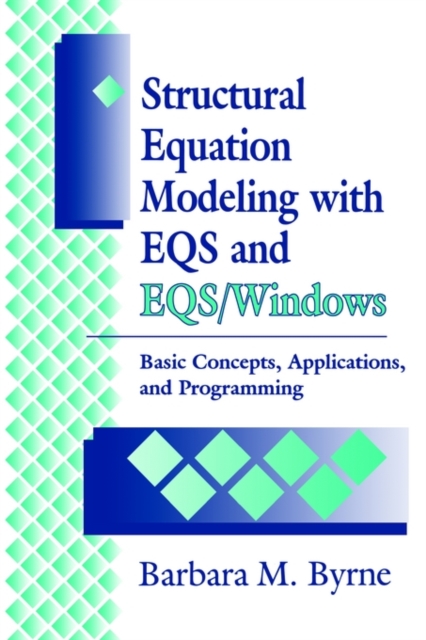
Structural Equation Modeling with EQS and EQS/WINDOWS : Basic Concepts, Applications, and Programming Paperback / softback
by Barbara Byrne
Paperback / softback
Description
"The strongest attribute of Barbara M. Byrne's book is her superb organization both across chapters and within chapters. . . . Aside from the logical layout of chapters, a great deal of helpful organization exists on many other levels.
After making readers comfortable with the details of the input and output files, Byrne gradually weans us away from the masses of information that would otherwise be redundant; she does, however, remind us of key points from time to time, almost anticipating readers' questions. . . . Organization within chapters is also quite sound. . . . Her EQS input files are neatly structured so that indicators of a common factor are indented to the same degree. . . . All application chapters nicely conclude with references to other examples of the application under study. . . . As should be obvious by now, I was fairly pleased with what I found in Byrne's book. . . . As the book unfolds she does a nice job of addressing many topics within the context of her applications. . . . It has strong value as a tool for teachers and practitioners." --Gregory R.
Hancock in Structural Equation Modeling "Several features of the illustrations will be beneficial to SEM novices.
The EQS programming and interpretation are presented clearly and in detail so that readers should have little trouble applying the concepts in their own research.
An especially nice feature is that, as is usual with ''real'' data, things ''go wrong.'' . . . Seeing realistic rather than idealistic applications is good preparation for practicing and interpreting SEM. . . . The major benefit of the books to experienced modelers who are new to EQS is the convenience of having detailed examples to follow.
None of Barbara M. Byrne's applications involve ''tricks'' or steps that would not be clear from the EQS and EQS/Windows manuals. . . . Byrne's step-by-step detail and integrated discussion of data screening and model respecification can reduce the time spent fixing minor errors in program setups or searching through the manuals for desired options. . . . The book is a fine production. . . . Newcomers to SEM who want to use EQS or EQS/Windows would benefit greatly from this book, either for self-teaching or as a supplemental text in a course.
Experienced modelers will benefit less, but spending a few hours with the book will move them well along the EQS learning curve.
Byrne intends her books ''to provide a practical guide to SEM using the EQS approach.'' She succeeds admirably." --George R.
Franke in Journal of Marketing Research "For each chapter, the author has been very successful in conveying complicated concepts involved in structural equation modeling with explanations that are easy to understand for users with little background in SEM.
The examples used in this book represent a broad range of research topics in the area of SEM.
The author also provides precise linkage between the null hypothesis to be tested, the specific setup of EQS programs, and clear explanations of the results.
Beginners of SEM can benefit substantially from this down-to-earth approach." --Chih-Ping Chou, University of Southern California "Byrne's book is a delightfully written, systematic approach to the practical use of structural equation modeling in research.
It begins with first principles and advances systematically through intermediate and advanced topics, introducing at each step the theory that is relevant as well as the practical models needed to implement these ideas on real models used in actual research contexts.
The reader can then easily modify the examples for their own research since the types of models discussed will be relevant in many research contexts.
Mathematical and statistical details are minimized so that the book should appeal to a broad audience.
The book is also timely, being the first text to show how statistics generally, and modeling in particular, can be fun in the Windows environment." --Peter M.
Bentler, University of California, Los Angeles Researchers and students who want a less technical alternative to the EQS manual will find exactly what they're looking for in this practical volume.
Designed to help beginners estimate and test structural equation modeling (SEM) using the EQS approach, this practical volume clearly explains and demonstrates a wide variety of SEM/EQS applications that include both partial factor analytic and full latent variable models.
Beginning with an overview of the basic concepts of SEM and the EQS program, the author carefully works through applications starting with the easiest, a single sample approach, through to more advanced applications, such as a multi-sample approach.
The book concludes with a section on using EQS for modeling with Windows.
Information
-
Out of stock
- Format:Paperback / softback
- Pages:304 pages
- Publisher:SAGE Publications Inc
- Publication Date:19/04/1994
- Category:
- ISBN:9780803950924
Other Formats
- Hardback from £143.00
Information
-
Out of stock
- Format:Paperback / softback
- Pages:304 pages
- Publisher:SAGE Publications Inc
- Publication Date:19/04/1994
- Category:
- ISBN:9780803950924






